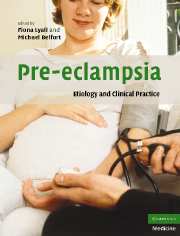Book contents
- Frontmatter
- Contents
- List of contributors
- Preface
- Part I Basic science
- 1 Trophoblast invasion in pre-eclampsia and other pregnancy disorders
- 2 Development of the utero-placental circulation: purported mechanisms for cytotrophoblast invasion in normal pregnancy and pre-eclampsia
- 3 In vitro models for studying pre-eclampsia
- 4 Endothelial factors
- 5 The renin–angiotensin system in pre-eclampsia
- 6 Immunological factors and placentation: implications for pre-eclampsia
- 7 Immunological factors and placentation: implications for pre-eclampsia
- 8 The role of oxidative stress in pre-eclampsia
- 9 Placental hypoxia, hyperoxia and ischemia–reperfusion injury in pre-eclampsia
- 10 Tenney–Parker changes and apoptotic versus necrotic shedding of trophoblast in normal pregnancy and pre-eclampsia
- 11 Dyslipidemia and pre-eclampsia
- 12 Pre-eclampsia a two-stage disorder: what is the linkage? Are there directed fetal/placental signals?
- 13 High altitude and pre-eclampsia
- 14 The use of mouse models to explore fetal–maternal interactions underlying pre-eclampsia
- 15 Prediction of pre-eclampsia
- 16 Long-term implications of pre-eclampsia for maternal health
- Part II Clinical Practice
- Subject index
- References
2 - Development of the utero-placental circulation: purported mechanisms for cytotrophoblast invasion in normal pregnancy and pre-eclampsia
from Part I - Basic science
Published online by Cambridge University Press: 03 September 2009
- Frontmatter
- Contents
- List of contributors
- Preface
- Part I Basic science
- 1 Trophoblast invasion in pre-eclampsia and other pregnancy disorders
- 2 Development of the utero-placental circulation: purported mechanisms for cytotrophoblast invasion in normal pregnancy and pre-eclampsia
- 3 In vitro models for studying pre-eclampsia
- 4 Endothelial factors
- 5 The renin–angiotensin system in pre-eclampsia
- 6 Immunological factors and placentation: implications for pre-eclampsia
- 7 Immunological factors and placentation: implications for pre-eclampsia
- 8 The role of oxidative stress in pre-eclampsia
- 9 Placental hypoxia, hyperoxia and ischemia–reperfusion injury in pre-eclampsia
- 10 Tenney–Parker changes and apoptotic versus necrotic shedding of trophoblast in normal pregnancy and pre-eclampsia
- 11 Dyslipidemia and pre-eclampsia
- 12 Pre-eclampsia a two-stage disorder: what is the linkage? Are there directed fetal/placental signals?
- 13 High altitude and pre-eclampsia
- 14 The use of mouse models to explore fetal–maternal interactions underlying pre-eclampsia
- 15 Prediction of pre-eclampsia
- 16 Long-term implications of pre-eclampsia for maternal health
- Part II Clinical Practice
- Subject index
- References
Summary
Introduction: the placental bed
The placental bed underlies the fetal placenta and includes the decidua basalis and the underlying myometrium containing the uterine spiral arteries. In order to establish human hemochorial placentation and to provide a progressive increase in blood supply to the growing fetus, the placental bed spiral arteries must undergo considerable alterations. These physiological modifications are thought to be brought about by the interaction of invasive cytotrophoblast with the spiral artery vessel wall. Failure of spiral artery transformation is thought to play an important role in the sequence of events which gives rise to pre-eclampsia. The mechanisms that control human trophoblast invasion in normal, let alone abnormal pregnancy, are still poorly understood. This is partly due to difficulties in obtaining “true” placental bed biopsies.
Much of the information on the early physiological changes within the placental bed comes from unique studies on intact hysterectomy specimens (Pijnenborg et al., 1981) Details of trophoblast invasion during late pregnancy and in pregnancies complicated by pre-eclampsia and fetal growth restriction is principally derived from the study of placental bed biopsies taken at the time of Cesarean section. Placental bed biopsies may not be representative of the whole placental bed. To help circumvent this problem, multiple biopsies combined with large numbers of cases should help to provide a more representative picture. The entire blood vessel will not be present in a single biopsy, thus limiting our interpretation of what is happening along its full length.
- Type
- Chapter
- Information
- Pre-eclampsiaEtiology and Clinical Practice, pp. 20 - 36Publisher: Cambridge University PressPrint publication year: 2007



